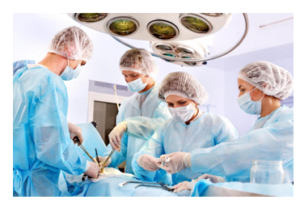Cervical Radiculopathy Surgery
Surgery

Definition: Surgery is a medical procedure performed by a skilled surgeon using various techniques to repair, remove, or correct problematic tissues or structures in the body.
For cervical radiculopathy—a condition where nerve roots in the neck are compressed or irritated—surgery is considered when non-invasive treatments (like medications and physiotherapy) haven’t provided sufficient relief. It aims to directly address the root cause of the nerve compression.
Cervical Radiculopathy Surgery
Definition
This refers to a specific surgical intervention that focuses on relieving the pressure on the nerve roots in the cervical (neck) region.
Common Procedures
- Discectomy
In this procedure, the surgeon removes the portion of a herniated disc that is pressing on the nerve. This helps alleviate the pain and other symptoms caused by the disc material interfering with nerve function. - Foraminotomy
This surgery involves widening the foramen (the small passageway where the nerve exits the spinal column) by removing bone or tissue that is narrowing the opening. This provides more space for the nerve, thereby reducing compression and irritation. - Cervical Fusion
Also known as spinal fusion, this procedure involves joining two or more vertebrae together using bone grafts or metal implants. This stabilization prevents movement that could continue to irritate the nerve roots.
Each procedure is chosen based on the specific cause of the nerve compression, the severity of symptoms, and the patient’s overall health.
Cervical Radiculopathy Surgery Recovery Time
Definition
This term describes the period required for a patient to heal and regain normal function after undergoing cervical radiculopathy surgery.
Details
- Short-Term Recovery:
- Immediately after surgery, most patients spend several days in the hospital.
- The early phase focuses on managing pain, reducing swelling, and initiating gentle movements to prevent stiffness.
- Initial physical therapy may begin within the first few weeks to encourage mobility.
- Long-Term Recovery:
- Full recovery often takes several months.
- Patients gradually increase their activity levels and continue with a structured physical therapy program to rebuild strength, flexibility, and overall function.
- Regular follow-ups with the healthcare team are essential to monitor progress and adjust rehabilitation as needed.
- The timeline for returning to work or daily activities varies based on individual progress and the complexity of the surgery.
Cervical Radiculopathy Surgery Cost
Definition
This involves the total financial expense associated with the surgery, covering all aspects from the procedure itself to postoperative care.
Considerations
- Hospital and Facility Fees: These include costs related to the operating room, recovery facilities, and any specialized equipment used during surgery.
- Surgeon and Anaesthesia Fees: These fees cover the expertise of the surgical team and the anaesthesia required during the procedure.
- Postoperative Care: Costs may also encompass follow-up visits, physical therapy sessions, medications, and potential management of any complications that arise.
- Variability:
- Costs can differ significantly based on the geographic region, the specific healthcare facility, and the individual patient’s needs.
- In some cases, the overall cost can range from several thousand to tens of thousands of dollars.
- Insurance
It’s vital to review your insurance policy to understand coverage details and any out-of-pocket expenses. Consulting with healthcare providers about financial assistance programs is also recommended.
Imagine your neck is like a busy highway where nerves are the cars. In cervical radiculopathy, it’s as if there’s a traffic jam caused by a blockage—this could be a herniated disc or bone spur—leading to pain and discomfort. Surgery is like a major road repair that removes the blockage entirely, but it’s invasive and takes time to recover.
Now, think of the Curapod machine as a high-tech “traffic controller” that uses specialized light therapy to ease congestion. Curapod gently reduces inflammation and calms the irritated nerves, making it easier for your body to heal naturally. It’s a non-invasive, drug-free option that can relieve pain and improve mobility, often helping you avoid or delay the need for surgery. In simple terms, while surgery is a full-scale repair, Curapod is like a tune-up that helps your neck run more smoothly without the risks and downtime associated with an operation.


